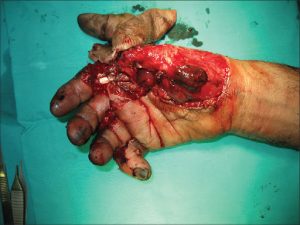hand-trauma

When we talk about hand trauma or Hand Surgery, we mean major injuries/cuts that have been sustained to the hand. The initial treatment of hand trauma frequently needs access to microsurgical facilities for small vessel and nerve repair. Such facilities need to be available on a 24 hour-a-day basis.
At present, this service is best implemented in medium-sized or larger plastic surgery units with suitable operating facilities and follow-up hand clinics, with expert physiotherapists and occupational therapists on site. This may, therefore, include transferring patients from other acute hospitals if such equipment and expertise are not available.
The most common procedures in hand surgery are those done to repair injured hands, including injuries to the:
- Tendons, nerves, blood vessels and joints
- Fractured bones
- Burns, cuts and other injuries to the skin
Techniques used by Specialist Plastic Surgeons include:
- Grafting
– the transfer of skin, bone, nerves, or other tissue from a healthy part of the body to repair the injured part - Flap surgery
– moving the skin along with its underlying fat, blood vessels, and muscle from a healthy part of the body to the injured site - Replantation or transplantation
– restoring accidentally amputated fingers or hands using microsurgery, an extremely precise and delicate surgery performed under magnification. Some injuries may require several operations over an extended period of time
What surgery is available, and what techniques are used?
Hand trauma surgery differs according to the nature of the injury sustained. Burns and skin loss, for a case, will require surgical flaps and grafts, while the traumatic loss of digits may be treated by what is known as toe to hand surgery.
Toe to hand surgery requires the microsurgical transfer of digits from the foot to the hand. The absence of a finger does not usually have much effect on either the function or the presence of the hand, but when the absent digit is a thumb, or when many digits are missing, surgery may be needed.
Usually, the guideline in considering reconstruction is whether or not the overall function of the hand may be fixed, although it is also natural and necessary to take into consideration the presence of the hand.
Whichever toe is transferred, its blood vessels (artery and nerve) must be successfully connected to similar vessels in the hand for it to survive. Tendons (to allow movement where required), nerves (to allow feeling), and the bone must also be joined to suitable counterparts in the hand.
What can I expect as a patient?
Following the microsurgical transplantation of a toe to the hand, the whole arm is immobilized in a dressing that involves a plaster splint. This will usually be left undisturbed for two or three weeks before the first change of dressing. The first change of dressing will be conducted either under a brief anesthetic in theatre or on the ward if only a simple removal of the dressing is needed. Usually, stitches will be absorbable and do not require removal, whilst the pins used to fix the bones may be removed without an anesthetic.
Follow-Up
Regular follow-up appointments are essential, and occasionally minor repositioning procedures are needed, while secondary surgery may be necessary for the adjustment of scars or bones. To know more you can concern with Dr. Rahul Dalal he is a highly qualified, skillful, and internationally trained Plastic & Cosmetic Surgeon in Pune. As he experiences Hand surgery in Pune
